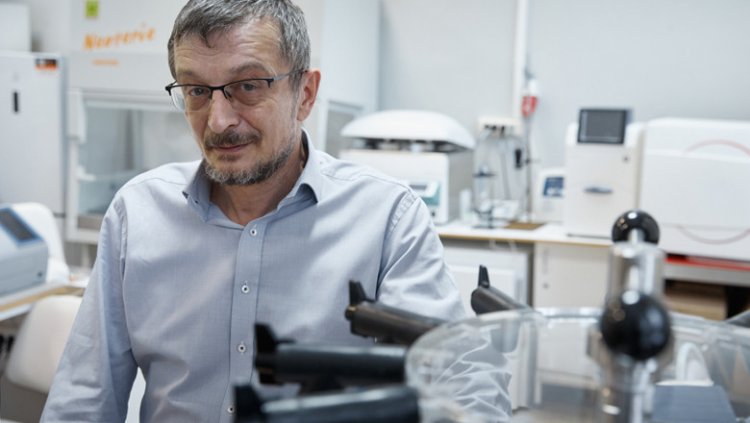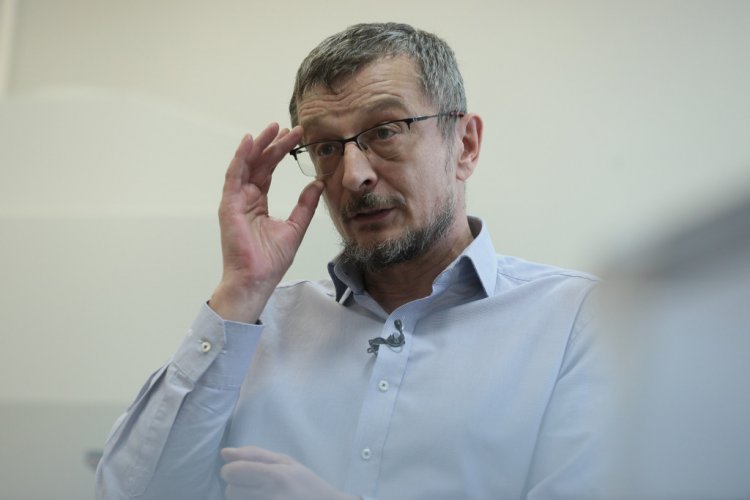The Paris Agreement adopted in 2016 is aimed at combatting global warming. Greenhouse gas emissions are believed to be the main reason behind the global warming. Thus, energetics using organic fuel was declared to blame for anthropogenic emissions. In order to comply with the requirements of Paris Agreement, radical changes should be obviously made in the structure of global energy industry. Many countries say about complete rejection of traditional raw materials in favor of hydrogen and mean it. What about Russia? Today, research organizations, as well as representatives of industrial and energy sectors try to develop the sphere that many people in Russia, producer of raw materials, look awry at so far. Does hydrogen constitute a threat or new opportunity for our country? Yuri Dobrovolsky answers these questions.
Yuri Dobrovolsky, doctor of chemistry, professor, head of the Competence Center of National Technological Initiative New and Mobile Energy Sources under the Institute of Chemical Physics Problems (ICPP) RAS in Chernogolovka.
— What are goals and objectives of the Competence Center?
— The Center, among other ones, was founded in late 2017. Its mission is formulated in special program – National Technological Initiative. The Center was founded for the purpose of overcoming technological barriers within the framework of pass-through technology for such markets as AutoNet, AirNet, MariNet and EnergyNet, the most industry-specific for us. The task of center New and Mobile Energy Sources lies in developing new technologies, creating a consortium of research, education and technological partners, as well as raising to prototype models the energy sources – electrochemical and photovoltaic – which are the most sought-after today.
At the initial stage, it was clear to us that we cannot cultivate the markets that have been occupied in the West long ago. Thus, we had to make several steps forward and deal with development of fundamentally new technologies. Having assessed our abilities, the employees of the Center forecasted that hydrogen topic would become the most relevant one in energy industry and transport in 2020. As you see, we have been right.
That is why we have fully accomplished one of the tasks – the one dealing with forecasting new trends. Now, we must follow the relevant trends in energy industry and create technologies which will become popular in the near future.
— What does notion hydrogen energetics mean? Is this kind of energy in demand today and to what extent?
— I would take a broad view of this issue. The matter in question is not as much about hydrogen energetics as about hydrogen economy in general. What is the reason behind the rising interest? This agenda is directly linked to the problems of climatic changes and reducing CO2 emission. If we agree with the theory of anthropogenic impact, these problems should be obviously studied. This motivation looks quite clear for me.
Will hydrogen solve all of our problems? Let us say that for the energy industry in its present form of burning fossil fuel and transforming the resulting heat into electric energy hydrogen is not the best energy producing material. Meanwhile, it is a chemical product that is actively used in metallurgy, chemical and petrochemical industries. The majority of nitrogen fertilizers are produced using hydrogen.
For us, it is a chance to make not only energy industry but economy in general green.
However, the topic is still ambiguous, as we cannot call the hydrogen used today clean and green. What does it mean? Some time before, the global community has divided hydrogen into several conventional colors by the source type for simpler perception. The cleanest hydrogen, the one that we strive for today, is green. It is the hydrogen produced from renewable energy sources by way of water electrolysis. This cycle suggests no greenhouse gas emissions. As a scientist, I should say that there are no products in the world without carbon footprint. CO2 is released at some stage of production anyway. However, green hydrogen is produced by the method that the closest one to cutting-edge technologies ruling out emissions. Yet, we should not forget that the hydrogen produced by way of electrolysis is the most expensive one as well.
Orange hydrogen is produced with the help of energy generated by nuclear power plants. Along with these types, there are gray and blue kinds of hydrogen. Gray type accounts for the major part of the cheapest hydrogen. It is produced from natural gas by way of steam-gas inversion. Water is mixed with natural gas, heated on catalyzer, and the output is the mixture of hydrogen and carbon dioxide (the CO2 that we combat with). Blue type is the hydrogen produced in the same manner as gray one, yet carbon dioxide is somehow buried not to let it be released into the atmosphere.
There is also turquoise hydrogen. It is produced from hydrocarbons too, but the output includes some forms of pure carbon, coal soot for instance, instead of CO2. It is a familiar product for us. We know where and how to use and store it.
Today, hydrogen energetics is on the agenda of politicians and economists. Many countries have adopted programs on its development. Hydrogen can ensure the whole chain of manufacturing different products.
Though hydrogen is not the best fuel for energy industry, it is comfortably in line with renewable energy production, solar and wind ones. Renewable energy sources always feature an intermittent production cycle. So, the surplus of energy requires being accumulated somewhere in order to spend it in periods when we are short of energy. The existing technologies are very expensive so far. As for hydrogen, it promises almost infinite storage period and can be used as a source of energy for transport within the framework of green energetics. It is the problem that we are active in working on nowadays.
— One has to produce hydrogen before using it. What experience has been accumulated in this area?
— We, as a consortium of research and educational organizations, have really accumulated vast experience in producing and using hydrogen. We have managed to set up and running the development of model specimens and transfer of them to our industry partners for production. Here, on the territory of the Institute of Chemical Physics Problems in Chernogolovka, we have a center which has been traditionally dealing with production of hydrogen and processing of hydrocarbons. Our institution has been dealing with this subject for many decades. That is why it was easy for us to start the research when the Competence Center was founded, as the skills required for production and use of hydrogen had been gained already.
Along with that, we cooperate with colleagues from Tomsk and Moscow in projects dealing with production of pyrolysis or turquoise hydrogen. By the way, our country alone can boast of such scientific developments. The first prototype is ready.
When the matter in question is about transport – airplanes, motor vehicles, trains, etc. – one should create fueling systems, preferably cheap ones, otherwise the idea will hardly be applicable. We have such a system. We try to get the said green hydrogen with the help of electrolysis unit. However, there is no talk about it being ecologically clean so far, as we get electric energy from the wall socket instead of wind generators or solar panels.
Our present goal lies in designing a facility for industry capable of producing cheap hydrogen by different methods depending upon the raw materials.
Electrolyzer for producing hydrogen
Details of electrolyzer for producing hydrogen
— What results can you boast of now?
— Over the past half a year, we have designed an operational electrolyzer for fueling station. The period looks impressively short. It is generally assumed that the acceptable cycle from the start of project to the first prototype model is 3-5 years.
A task of making the first Russian large electrolyzer for fueling station has been set to the company that the graduates of our postgraduate studies department at our institute are in charge of. The device will be connected to the facility as early as this spring. It took us exactly 6 months to finalize the technology and produce an operational prototype model. By the way, foreign colleagues have recently visited our institute for negotiations on testing hydrogen transport with the use of our fueling system.
— Does the state show any interest in expert forecasts and technologies created by you and your colleagues?
— The interest is great, yet only verbal so far. Too little time has passed since the program was initiated on the state level. In December 2020, President Vladimir Putin said that buses using hydrogen fuel would appear in the streets of Moscow in 2023. Naturally, there will be no mass production of such busses in 2023. Well, the first prototype model may probably be designed by that time. Anyway, it is too short a period for building the required infrastructure. Nevertheless, it is fine that this issue in on the agenda of the government.
Besides, the Energy Ministry laid the foundation for the implementation of program dealing with development of hydrogen energetics in Russia. The roadmap will soon be ready. I am a member of the working group dealing with its development, while the accompanying documents being drawn are based on our analytical data. The employees of Competence Center have implemented an analytical project devoted to development of hydrogen energetics in Russia. We have completed another similar project for Rosatom. Who could ever think that Rosatom will be involved in projects on producing and using hydrogen?!
— Russia, as a raw materials producer, aims at development of hydrogen energetics. The program for the period to 2050 has been worked out.
— So far, the program for the period to 2035 is ready. The one for the period to 2050 will be adopted soon.
— Will we be able to switch over to this energy source and move away from oil and gas extraction?
— The question is certainly complicated. Why do we see heated debates on hydrogen in Russia? First, Russia, frankly speaking, is not a technological power anymore, but a producer of raw materials, and export of hydrocarbons accounts for the major part of the country’s budget. Taking a good look at the forecasts of European companies, we can see that the share of gas export will reduce at the expense of increasing export of hydrogen. So, a logical question arises – should we take part in it? Aren’t we running the risk of losing a part of our incomes?
It is clear that there are certain risks, especially on condition of Russia starting to produce only blue hydrogen. According to the most ambitious forecasts, only half of produced hydrogen will be green, while the other half will feature blue color. Other types are not even considered in the existing development programs adopted in different countries.
Besides, striving for hydrogen energetics, we meet with the problem of transporting hydrogen. It is hard to transport and store it. Actually, the production of hydrogen is estimated at billions of tons. Yet, it is produced and consumed at one and the same place.
The export problem is acute for Europe as well. They will not be able to produce as much hydrogen as they plan to use within the framework of approved programs. Thus, they will be dependent upon the import of this raw material. Whether hydrogen will be imported from Russia, African countries or states of South America depends upon many reasons, including our readiness for supplying hydrogen. Moreover, we are talking about hydrogen that is to become greener by 2050.
It is obvious that the consumption of natural gas will reduce. However, it is not yet clear whether we will replace it with hydrogen or not, though the problem of transportation has been partially solved, as the method of supplying it via pipelines is the cheapest one.
The main idea that I (and some politicians) promote lies in the fact that Russia will fall far behind other countries without domestic consumption of hydrogen and the respective infrastructure. We can build wind turbines and electrolyzers, but they will be useless without domestic consumption. For Russia, transport looks the most appropriate area for domestic consumption of hydrogen. The existing electric motor vehicles with batteries are unfit for long distances and extreme weather conditions typical of our country. Hydrogen fuel cells, as well as surplus heat generated by them that can be also used, is a wonderful alternative. It is the very benefit of hydrogen energetics specifically for Russia and other cold countries.
This line of development may become a driver for our economy. We have a chance to save Russian automotive industry from lagging behind. We see great interest on the part of KamAZ and GAZ – the leading corporation of automotive sector. Even RZD plans to switch over to hydrogen as fuel for its locomotives.
The second interesting issue is related to the export of metals, nitrogen fertilizers and other products of chemical industry. The introduction of carbon tax will make the production of green hydrogen more profitable, while our country will get a new competitive advantage.
In the long run, hydrogen fuel is the most ecologically clean one. Only water remains in the process of using it. The only method of solving the problem is directly related to the introduction of electric transport, and hydrogen one for Russia.
Very soon, we will publish an article based on our calculations as to the economic figures and carbon dioxide emissions of various types of buses. AS it follows from these calculations, a bus using hydrogen as fuel is even now an ecologically justified phenomenon for Moscow region.
— Which research tasks should be accomplished in the first turn? You have talked a lot about technologies, creation of mobile energy sources and batteries for them. What about fundamental tasks?
— There are fabulously many of them at every stage of producing, storing, transporting and processing hydrogen into electric energy or any other product. One of the most relevant objectives lies in producing hydrogen by cheaper method if compared to electrolysis. I mean photochemical catalysis for instance. It is a photo-biological method of producing hydrogen literally from dirt.
The second fundamental problem is about the storage of hydrogen. So far, we have not yet learned how to transport and store hydrogen in the right way. That is why the cost of hydrogen is mostly made up of logistics prices: storage and transfer. There are many interesting scholar papers devoted to this very problem: they suggest, for instance, storing hydrogen in various organic compounds.
As for the third problem, we, among other players, are trying to solve it. The matter in question is about creating fuel cells. Today, only two types of fuel cells are actively made use of: solid-polymer and solid-oxide ones. The most promising area of development is related to intermediate temperature fuel cells. The prototype models of them exist already. However, their efficiency is much poorer that the one of the cells that we already use. I hope that these technologies will make more headway in the future and provide us with new kinds of ecologically clean transport and other cutting-edge technological solutions.
— What should we expect for hydrogen energetics in future?
— Over the next five years, we should expect many new methods of producing hydrogen and individual suggestions dealing with its transportation: by sea from Australia to Japan, via pipelines of European states, domestic transportation countrywide in organic and inorganic carriers, etc. We do not know exactly which of the methods will look preferable in the long run, yet the experiments in this sphere will be definitely continued in the years to come.
Along with that, we are to expect an explosion of interest in hydrogen-operated equipment. As far as Europe is concerned, it is evident right now. Recently the employees of Solaris, one of the largest bus producing companies, have paid a visit to us. According to their information, the orders for hydrogen-operated buses have been completely finalized for the period to 2022. Moreover, as far as the orders for electric buses which they also manufacture are concerned, the company has received them only for the period to 2021.
A story of its own for Russia is about locomotives of new generation. The calculations show that a hydrogen-operated locomotive will be in demand. The prototype model will be produced in Russia as early as next year.
Water transport will demonstrate rapid development as well. Even today, the ecological requirements for coastwise vessels (the ships which sail among sea ports of the same state) suggest zero environmental pollution. This goal can be achieved by only two ways: using batteries or hydrogen.
Naturally, we must not forget about air transport. Unfortunately, the civil aircraft engineering sector shows poor development in Russia. As for the Western countries, this industry is rapidly developing there. The forecasts anticipate that small airplanes performing short-distance flights will definitely be switched over to hydrogen, while large aircrafts will be equipped with hydrogen-operated auxiliary power generation machines. Such giants as Boeing and Airbus say that their airplanes will use hydrogen as fuel by 2035. Frankly speaking, I am skeptical about it. Let me remind you that one of the first airplanes using hydrogen as fuel – TU-155 – was flying in the USSR back in the past century. Boeing and Airbus are trying to design something similar in a new way.
Naturally, the use of hydrogen may sometimes look unjustified. However, we still more often talk about switching over from hydrocarbon economy to the one based on renewable energy sources, and hydrogen is one of the key components in this regard.






































